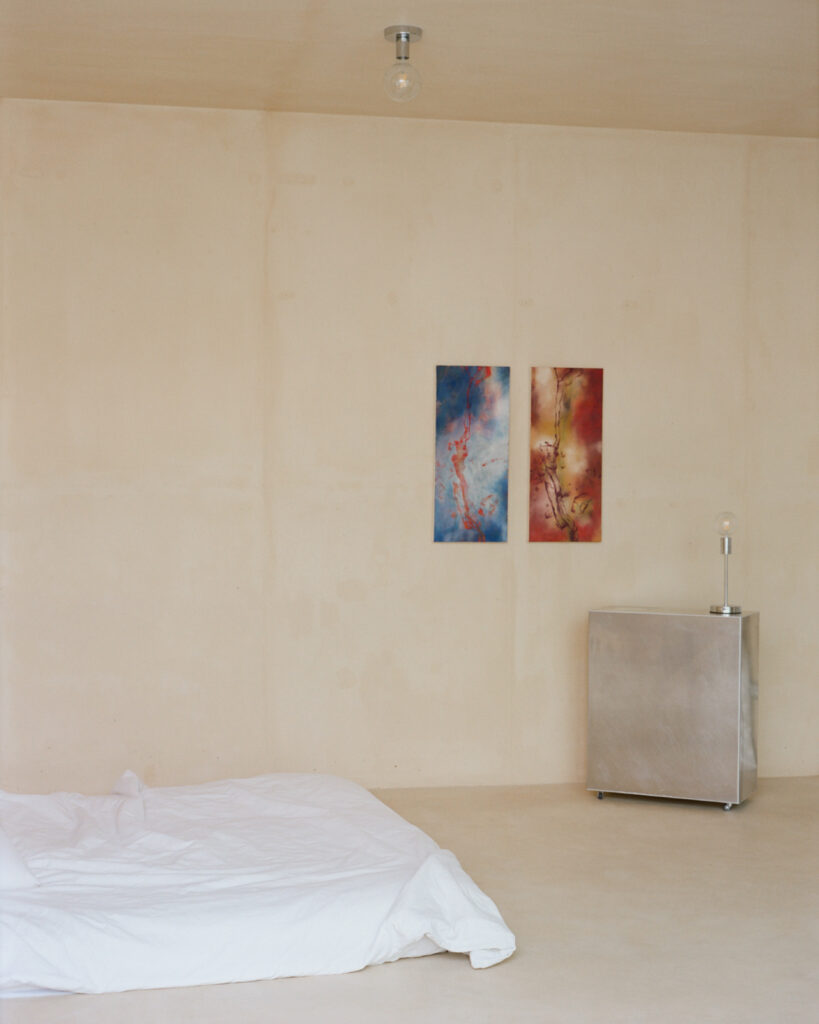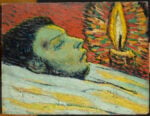Emma Moriconi – Intimus

I invited Emma to observe her works within the intimate and domestic space of Villa Clea, and together we reflected on the concept of intimacy
Comunicato stampa
I invited Emma to observe her works within the intimate and domestic space of Villa Clea, and together we reflected on the concept of intimacy. Her paintings depict minerals and living organisms seen up close, which resemble or could be mappings of living bodies and organs from the inside. The intimate nature of the inner environment, the connection between the physicality of a living organism and the matter of a mineral essence. The infinitesimal closeness of observation through a microscope mirrors the philosophical connection between the individual and the universal. “We are made up of the same atoms and the same light signals as are exchanged between pine trees in the mountains and stars in the galaxies.” (Carlo Ravelli, Sette brevi lezioni di fisica). The deeply human emotion of realizing that we are made of the same substance as the environment of which we are part, carries us from scientific inquiry to philosophical investigation. In our individuality, which is transcribed in the unique stories we tell and the particular and singular mappings of our inner bodies, we retain the universality of our connection with the whole, with the rest of the narrative, blurring thanks to intimate observation ourselves and everything else.
Emma: Lately, I’ve been thinking a lot about intimacy. I’ve reflected on it deeply, especially in recent times. Even if I take minerals or organism as subject of my paintings, what I’m working on now is closely tied to the inner most, the root, and how that connects to my personal experiences.
Allina: Historically, there’s always been this division between mind and body, as if the mind were superior and the body something inferior. But today, with scientific discoveries, we understand that the mind and body are deeply interconnected. There’s a visceral intimacy that comes from our being a unified whole, and I believe this is quite evident in your work.
Emma: I’m very interested in exploring this interconnection. Etel Adnan evoked it so beautifully when she wrote “I love rains which carry desires / to / oceans...You and I are made from / a worm-eaten wood”. I find her words incredibly powerful—it speaks to how we’re all made of the same substances, whether biological or mineral. I aspire to capture the agency and power of natural pheonema. It’s fascinating to think that we’re all connected in some way.
Allina: You merge the visceral with the poetic in your work. There’s a strong material presence in your pieces, but at the same time, you convey a certain emotional delicacy. It’s as though your work exists in this space between the physical and the emotional, between the personal and the universal. Emma: For me, it’s essential to explore that space of connection. For instance, I’ve recently been focusing a lot on symbiosis, the exchange of nutrients and organic matter, as well as the structural elements of these organisms. I find it to be a perfect metaphor for exploring human, biologic, and geologic intimacy. Our bodies are composed of elements that are both living and non-living, and that fascinates me. We’re made of minerals, bacteria, fungi— all of which find visual and poetic expression in my work. Allina: There’s a deeply philosophical aspect to your work, though the representation may appear scientific at first glance. But unlike science, where you seek answers, your work seems to pose questions, emotional ones. What do we share with our environment? Emma: Yes, I’m not interested in hyperrealism. I prefer to go beyond the surface and explore what lies beneath. I love working with microscopes, observing minerals and how they can resemble human anatomy—veins, tissues. I love scientific and botanical illustrations, but I intentionally blur the line between foreground and background with densly layered compositions.
Allina: In this sense, your work bridges the visible with the invisible, the external world with the internal—both in a physical and metaphorical sense.
Emma: For example, I have had to undergo numerous medical tests—ultrasounds and endoscopies—and looking inside my own body has been a beautiful discovery process. When I was diagnosed with an auto-immune disorder as a teenager, I began to think about what happens inside us, how our bodies are like living ecosystems.
This has greatly influenced my work. Allina: There’s an intimacy in that act of observing our own body, and it feels like you’ve translated that introspection into your work. It’s an exploration of intimacy in all its forms—not just physical but emotional as well.
Intimacy isn’t only about the body, but also about how we relate to our emotions and the world around us. Reflecting on these themes allows us to explore the visceral in a broader sense. Through your representations, you seem to connect the human body with the mineral and natural world. This gives your work a deeply personal
yet universal dimension. It’s as if, through the physical depiction of a single object or organism, we can see the interconnectedness of things on a plural and universal scale.
Emma: Yes, that’s it. I’m less concerned with representing the body in a realistic way; I’m more interested in exploring the connections between what we see on a daily basis and what we don’t, and how these innermost internal words are not as far from us as we may think.
Allina: It feels like you’re trying to link the internal world with the external, the microcosm with the macrocosm. That sensation reflects a union between personal intimacy and a sense of universality. And what I believe is that art has the power to make us feel this physical and emotional connection, both personal and universal, all at once.



